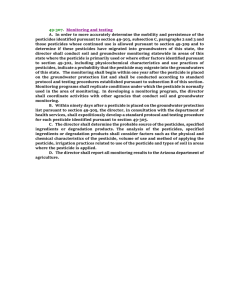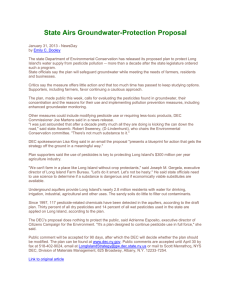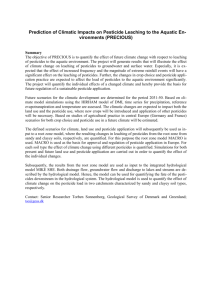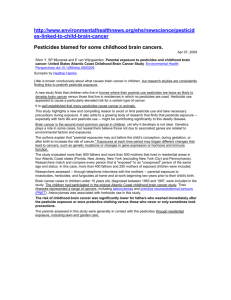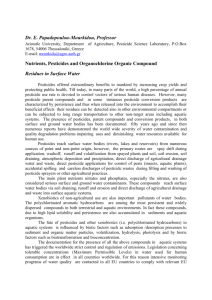Protecting groundwater (pesticides)
advertisement
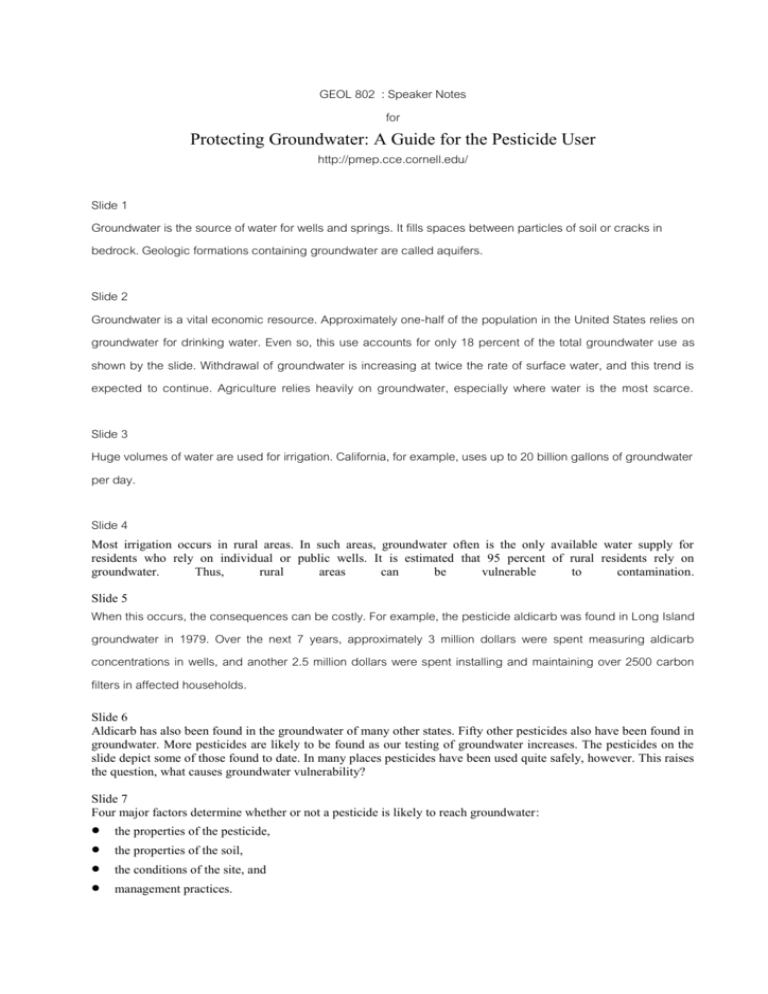
GEOL 802 : Speaker Notes for Protecting Groundwater: A Guide for the Pesticide User http://pmep.cce.cornell.edu/ Slide 1 Groundwater is the source of water for wells and springs. It fills spaces between particles of soil or cracks in bedrock. Geologic formations containing groundwater are called aquifers. Slide 2 Groundwater is a vital economic resource. Approximately one-half of the population in the United States relies on groundwater for drinking water. Even so, this use accounts for only 18 percent of the total groundwater use as shown by the slide. Withdrawal of groundwater is increasing at twice the rate of surface water, and this trend is expected to continue. Agriculture relies heavily on groundwater, especially where water is the most scarce. Slide 3 Huge volumes of water are used for irrigation. California, for example, uses up to 20 billion gallons of groundwater per day. Slide 4 Most irrigation occurs in rural areas. In such areas, groundwater often is the only available water supply for residents who rely on individual or public wells. It is estimated that 95 percent of rural residents rely on groundwater. Thus, rural areas can be vulnerable to contamination. Slide 5 When this occurs, the consequences can be costly. For example, the pesticide aldicarb was found in Long Island groundwater in 1979. Over the next 7 years, approximately 3 million dollars were spent measuring aldicarb concentrations in wells, and another 2.5 million dollars were spent installing and maintaining over 2500 carbon filters in affected households. Slide 6 Aldicarb has also been found in the groundwater of many other states. Fifty other pesticides also have been found in groundwater. More pesticides are likely to be found as our testing of groundwater increases. The pesticides on the slide depict some of those found to date. In many places pesticides have been used quite safely, however. This raises the question, what causes groundwater vulnerability? Slide 7 Four major factors determine whether or not a pesticide is likely to reach groundwater: the properties of the pesticide, the properties of the soil, the conditions of the site, and management practices. These factors explain why some pesticides have been found in groundwater and others have not, and why they have been found in some areas, but not in others. Slide 8 Not all pesticides are likely to move downwards. Volatile pesticides are easily lost to the atmosphere, similar to water evaporating, which means less will be available for leaching to groundwater. Volatile compounds, however, may become groundwater contaminants if soluble in water. EDB is an example of such a compound and is applied below the soil surface. Slide 9 For pesticides which enter soil, a key process is the pesticide's degradation. Pesticides are degraded by sunlight, microorganisms in the soil, and chemical and physical processes. Breakdown is faster at warmer temperatures. The longer the compound persists before its degradation, the longer it is subject to the forces of leaching. Slide 10 Degradation does not occur uniformly throughout the soil. For example, the vast majority of microbes live in the upper soil. If a chemical leaches or is introduced below the root zone, it will encounter far fewer microbes by whose actions it may be degraded. Also, temperatures are lower deeper in the soil. Therefore, if a pesticide moves below the root zone, it is a candidate leacher. Slide 11 The likelihood of a pesticide moving downwards depends largely on its ability to dissolve in water, or its solubility. If a pesticide is highly soluble, then it is more likely to move downward as shown by the darker water on the left. Slide 12 On the other hand, many pesticides, even some which are soluble, are likely to stick to soil particles by adsorption. Thus, if the probability of adsorption is high, then little of the chemical will leach. This is shown by the lighter colored water on the right. Slide 13 In addition to these properties of the pesticide, soil characteristics also affect leaching. Principle characteristics include: soil texture, soil permeability, soil organic matter content, and soil structure, including macropores. Slide 14 This is a photograph of an experiment demonstrating the effect of soil texture. Equal amounts of water were applied simultaneously to each of the three columns of soil. Sandy soil permits fast movement of percolating water, and lowers the opportunity for dissolved chemicals to be adsorbed. Clay and organic soils tend to hold water and dissolved chemicals longer. Also, these soils have more surface area on which pesticides can be adsorbed, in comparison with sandy soils. The sandier the soil, the greater the chance of a pesticide reaching groundwater. Slide 15 The rate of water movement is measured by soil permeability. Soils with low permeability readily form ponds as shown in the photograph. This may lead to runoff. On the other hand, permeable soils lose water quickly, so frequent irrigation may be necessary. This percolating water may cause pesticide leaching. Slide 16 Organic matter, such as that which is ploughed in, tends to increase retention of water. Since organic debris may also adsorb pesticides, its presence in soil serves a double benefit. Slide 17 Soil structure, the way soil particles are aggregated, also affects water movement through the soil. Sometimes large openings called macropores may be present in fine textured soils. Under certain conditions, the existence of macropores may result in rapid water movement through fine-textured soils. Slide 18 Conditions of the site also influence leaching of pesticides. The most important condition is depth to groundwater. Less filtering by the soil occurs for a shallow aquifer. Therefore, there is less opportunity for degradation or adsorption. In humid regions where groundwater may be a few feet below the surface of the soil, where rainfall is high, and where soils are permeable, water carrying dissolved pesticides may take only a few days to percolate to groundwater. Slide 19 Permeability of the geologic layers between the soil and groundwater is also important. Highly permeable materials, such as gravel deposits, depicted on the left, and highly fractured rocks, depicted on the right, allow water and dissolved pesticides to move freely downward to groundwater. Layers of clay, on the other hand, are much less permeable and thus inhibit water movement. Slide 20 As previously mentioned, temperature and rainfall can influence degradation and leaching. Areas with high rates of rainfall or irrigation have large amounts of water passing through the soil. Therefore, these areas are vulnerable to leaching of pesticides, especially if soils are highly permeable or temperatures are low. Slide 21 In summary, whether or not a pesticide will leach depends on many factors, including its chemical properties, the soil type, the depth to groundwater, and the way the pesticide is applied. Slide 22 The protection of vulnerable groundwater relies heavily on application techniques. A summary of preventative measures follows. Slide 23 The protection of vulnerable groundwater relies heavily on application techniques. A summary of preventative measures follows. Slide 24 Evaluate the need, method, and frequency of chemical control. Use pesticides only when necessary and only in amounts that will adequately control pests. Pesticides that are applied in low concentrations and less frequently are less likely to leach into the groundwater. Slide 25 Identify the vulnerability of the soil. As already explained, well-drained or sandy soils low in organic matter have a high potential for groundwater contamination. Slide 26 Consider the location of the pesticide application in relation to ground- and surface-water. Keep pesticides away from water sources. Avoid handling, loading, and mixing at or near surface waters, shallow aquifers, or a well site. Consult your Cooperative Extension Service or the Soil Conservation Service to determine the depth to groundwater in your area. Slide 27 Avoid using a pesticide that is likely to leach. Pesticides such as those shown with a high potential for leaching are more likely to contaminate groundwater. Check the pesticide label for any warnings about its potential to leach to groundwater. In addition, your Cooperative Extension Service or EPA can provide information on the leaching potential of different pesticides. Slide 28 Follow the directions on the pesticide label. Many pesticide labels contain information on groundwater contamination. Slide 29 A label for aldicarb or Temik is shown here. The area highlighted by a red color prescribes limits on the use of the chemical in Florida. If you do not follow the label, you risk contaminating the groundwater. Slide 30 Methods of application can protect groundwater while also giving adequate control of pests. Slide 31 Apply the pesticide at the appropriate time. Fewer applications are required if they are carefully timed in relation to pest problems, crop growth, rainfall and irrigation. Slide 32 Measure the pesticide properly and carefully. Avoid the temptation to use more than the label directs. Using more will not control pests better. It will only increase the cost of pest control, the resistance of pests to chemical controls, and the chances of contaminating groundwater. Slide 33 Calibrate and maintain equipment properly. Correctly calibrating application equipment before applying pesticides reduces chances of applying too much. Check your application equipment regularly for leaks, malfunctions, and calibration. You will save money and help prevent groundwater contamination. Slide 34 Avoid spills and back-siphoning. Avoid spills, especially within 25-50 feet of wells or near other water sources. Prevent back-siphoning of pesticide-contaminated water into the water source by keeping the end of the fill hose above the water level in the spray tank. Install a backflow device (such as an air gap or check valve) on the filling pipe to prevent backflow problems. Slide 35 Direct the application to the target site. Avoid over-spraying the ground and possible drift to reduce the chance of contaminating the groundwater. Slide 36 Dispose of pesticides properly. Triple rinse or pressure rinse pesticide containers, and return the rinse water to the spray tank. Follow the label directions for proper disposal of leftover pesticide, so they do not causegroundwater problems. The best precaution against pesticide disposal problems is good planning. Buy and mix only the amounts you need. Slide 37 Store pesticides safely. Store pesticides in their original container in a cool, well-ventilated, protected location away from pumps and water sources. Slide 38 Maintain records of pesticides used. Maintain records of the identity and quantity of pesticides applied to each area. Before applying pesticides, determine the need for chemical control and the amount and frequency of chemicals that are necessary, the soil type, and the location of ground- and surface-water. Choose a pesticide that is less likely to leach. Slide 39 When you apply pesticides, follow all directions on the label, carefully measure and mix the pesticide to avoid spills, and direct the application to the target site, avoiding water sources and over-spraying. Slide 40 After you have applied a pesticide, properly dispose or store the remaining pesticide according to the instructions on the label. Keep a record of the application. Slide 41 In addition to application techniques, there are other methods which can prevent groundwater contamination by pesticides. These include: timing irrigation, avoiding over irrigation, and checking your well system. Slide 42 Delay irrigation after pesticide applications. Because pesticides frequently move with water down through the soil, it is better to delay irrigation for one or more days after applying a pesticide. This can reduce the chances of the pesticide reaching the groundwater. Slide 43 Over irrigation should be avoided. Using the proper amount of irrigation and avoiding irrigation runoff will reduce soil erosion and pesticide entry into surface and groundwater. Slide 44 Chemigation requires particular care. Irrigation may carry pesticides downward through the soil into groundwater. Devices should be used to prevent possible backflow of pesticides into the water supply system. Materials used in pumps and seals should be compatible with the chemicals being injected. Check unattended systems frequently. Use only the amount of water needed to activate the pesticide. Slide 45 There are non-chemical means of controlling pests as illustrated by this trap. Integrated Pest Management uses strategies such as economic thresholds and pest monitoring to determine timing for pesticide applications. For example, by using traps to monitor the tobacco budworm, growers in North Carolina have reduced pesticide use against the pest by 53 percent. Tomato growers in California using an IPM program have increased their net returns by about $7.00 per acre and decreased their insecticide use by 22 percent. There are many other examples. Slide 46 IPM encourages beneficial organisms, such as ladybugs, as a natural means of control. IPM frequently improves the quality of the crop, and maintains or increases crop yield. Because of the reduced need for pesticides, groundwater contamination from pesticides is less likely to occur. Contact your Cooperative Extension agent for IPM information. Slide 47 Wells themselves can cause groundwater contamination. Properly seal new wells and inspect old wells to insure that the seal is adequate. This will help to keep contaminated surface water form entering the well and groundwater. Slide 48 Public water supply wells, such as that shown, can be vulnerable. Despite the best measures, sometimes drinking water wells do become contaminated. Slide 49 In addition to pesticides, it has long been understood that bacteria, nitrates, and common minerals such as calcium and magnesium can contaminate groundwater. The presence of these and other contaminants in groundwater may present a risk to public health. The impact of pesticide contaminated groundwater on human health is still being assessed. Slide 50 While any contamination of groundwater is a concern, how concerned one should be depends on what is found and at what level. Pesticide A causes cancer and could be a health concern, even at very low levels, if someone were to drink water contaminated by this pesticide.Pesticide B does not cause cancer, but is very acutely toxic and could cause immediate illness if present, even at low levels in drinking water.Pesticide C does not cause cancer and has a low acute toxicity. It would have to be found at high levels in drinking water to be a threat to health. Slide 51 The concentration of a pesticide found in the groundwater depends on the amount of pesticide reaching the soil surface, how it travels within the soil, and how quickly the pesticide is broken down. For example, a high application rate may lead to a high concentration of a pesticide in the soil. Then, if the pesticide is slow to breakdown, it may eventually contaminate nearby groundwater. Slide 52 Once a pesticide reaches groundwater and enters a drinking water supply, it may have an adverse effect on human health. The effects may be immediate, or acute, resulting from short-term exposure, or the effects may be long term, or chronic, resulting from more prolonged exposure. Most pesticides found in groundwater normally are not present in high enough concentrations to cause acute health effects. Slide 53 Because pesticides found in groundwater typically occur in small amounts and because exposure via drinking water can be long term, we are concerned primarily about their potential for causing chronic health problems. The type and severity of any health effect from chronic exposure depends on the type and amount of pesticide ingested. Slide 54 Exposure to a harmful substance may have reversible or irreversible effects on human health. Effects such as headaches and nausea are reversible, while cancer, birth defects, and damage to the nervous system are irreversible. Depending upon the substance, reversible and/or irreversible effects can result from short or long term exposure. Slide 55 Health advisories or drinking water standards being established for most pesticides by U.S. EPA, or in some cases by state agencies, are benchmarks for determining the concern one should have if a pesticide is found in their drinking water. Water supply system owners are required by law to treat water where a pesticide is found above a drinking water standard. Alternatives are to use wells that are not contaminated, or other supplies. Those responsible for contamination could be held liable for treatment costs or alternative water supply expenses. Slide 56 When wells are found to be contaminated above health advisories or drinking water standards, the pesticide concerned may be banned Slide 57 The best way to avoid water pollution and health problems is to prevent pesticides from reaching the groundwater. Pesticides should be kept out of groundwater because of their potential effects on human health. Pesticide applicators can help to prevent groundwater contamination by choosing pesticides with the least potential for leaching into the groundwater and by using only necessary amounts of pesticides, following the label, avoiding spills, and using proper disposal methods. Slide 58 To achieve prevention, farmers and applicators are encouraged to consult with Extension agents or other advisory specialists. If in doubt, consult. Prevention is the best remedy.
